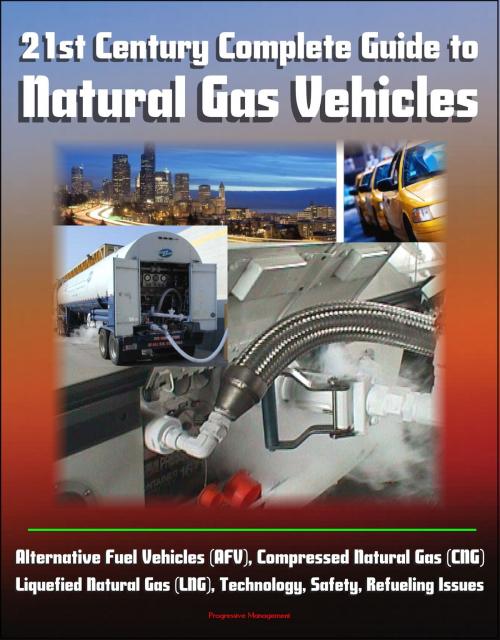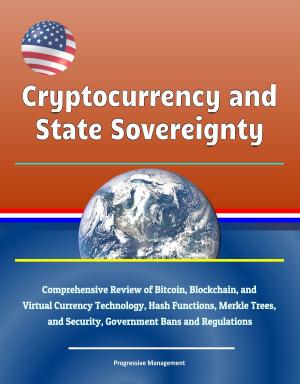21st Century Complete Guide to Natural Gas Vehicles - Alternative Fuel Vehicles (AFV), Compressed Natural Gas (CNG), Liquefied Natural Gas (LNG), Technology, Safety, Refueling Issues
Nonfiction, Science & Nature, Technology, Power Resources| Author: | Progressive Management | ISBN: | 9781301977451 |
| Publisher: | Progressive Management | Publication: | August 15, 2013 |
| Imprint: | Smashwords Edition | Language: | English |
| Author: | Progressive Management |
| ISBN: | 9781301977451 |
| Publisher: | Progressive Management |
| Publication: | August 15, 2013 |
| Imprint: | Smashwords Edition |
| Language: | English |
This comprehensive and up-to-date ebook provides a unique guide to natural gas vehicles, compiling ten official documents with details of every aspect of the issue: CNG and LNG designs, success stories, references, information on safety and refueling issues, and much more. Contents include:
Part 1: UPS CNG Truck Fleet Final Results, Alternative Fuel Truck Evaluation Project * Part 2: Clean Cities 2010 Vehicle Buyer's Guide - Natural Gas, Propane, Hybrid Electric, Ethanol, Biodiesel * Part 3: Natural Gas Vehicles: Status, Barriers, and Opportunities * Part 4: White Paper on Natural Gas Vehicles: Status, Barriers, and Opportunities * Part 5: Natural Gas Passenger Vehicles: Availability, Cost, and Performance * Part 6: Clean Alternative Fuels: Compressed Natural Gas * Part 7: Clean Alternative Fuels: Liquefied Natural Gas * Part 8: EPA Case Study: Tests Demonstrate Safety of Natural-Gas Vehicles for King County Police * Part 9: Resource Guide for Heavy-Duty LNG Vehicles, Infrastructure, and Support Operations * Part 10: Senate Hearing - Usage of Natural Gas - To Assess the Opportunities For, Current Level of Investment In, and Barriers to the Expanded Usage of Natural Gas as a Fuel for Transportation (2012)
While natural gas is often used as the energy source for residential, commercial, and industrial processes, engines designed to run on gasoline or diesel can also be modified to operate on natural gas — a clean burning fuel. Natural gas vehicles (NGVs) can be dedicated to natural gas as a fuel source, or they can be bi-fuel, running on either natural gas or gasoline, or natural gas or diesel, although most natural gas engines are spark ignited. Natural gas engine technologies can differ in the following ways: the method used to ignite the fuel in the cylinders, the air-fuel ratio, the compression ratio, and the resulting performance and emissions capabilities. Natural gas has a high octane rating, which in spark ignition engines (usual for CNG) allows an increase in power. However, natural gas occupies a larger volume in the cylinder than liquid fuels, reducing the number of oxygen molecules (share of air in the cylinder), which reduces power. The net effect on natural gas power vs. gasoline is relatively neutral. However, since it is a gaseous fuel at atmospheric pressure and occupies a considerably larger storage volume per unit of energy than refined petroleum liquids, it is stored on-board the vehicle in either a compressed gaseous or liquefied state. The storage requirements are still much greater than for refined petroleum products. This increases vehicle weight, which tends to reduce fuel economy. To become compressed natural gas (CNG), it is pressurized in a tank at up to 3,600 pounds per square inch. Typically, in sedans, the tank is mounted in the trunk or replaces the existing fuel tank; on trucks, the tank is mounted on the frame; and on buses, it is mounted on top of the roof. Although tanks can be made completely from metal, they are typically composed of metal liners reinforced by a wrap of composite fiber material with pressure-relief devices designed to withstand impact. Tanks do increase the vehicle weight, and with the lower energy density of natural gas, vehicle ranges are generally reduced. To become liquefied natural gas (LNG), natural gas is cooled to -260 °F and filtered to remove impurities. LNG is stored in double-wall, vacuum-insulated pressure tanks and is primarily used on heavy-duty trucks, providing increased range over CNG.
NGVs and their respective fueling systems must meet stringent industry and government standards for compression, storage, and fueling. They are designed to perform safely during both normal operations and crash situations.
This comprehensive and up-to-date ebook provides a unique guide to natural gas vehicles, compiling ten official documents with details of every aspect of the issue: CNG and LNG designs, success stories, references, information on safety and refueling issues, and much more. Contents include:
Part 1: UPS CNG Truck Fleet Final Results, Alternative Fuel Truck Evaluation Project * Part 2: Clean Cities 2010 Vehicle Buyer's Guide - Natural Gas, Propane, Hybrid Electric, Ethanol, Biodiesel * Part 3: Natural Gas Vehicles: Status, Barriers, and Opportunities * Part 4: White Paper on Natural Gas Vehicles: Status, Barriers, and Opportunities * Part 5: Natural Gas Passenger Vehicles: Availability, Cost, and Performance * Part 6: Clean Alternative Fuels: Compressed Natural Gas * Part 7: Clean Alternative Fuels: Liquefied Natural Gas * Part 8: EPA Case Study: Tests Demonstrate Safety of Natural-Gas Vehicles for King County Police * Part 9: Resource Guide for Heavy-Duty LNG Vehicles, Infrastructure, and Support Operations * Part 10: Senate Hearing - Usage of Natural Gas - To Assess the Opportunities For, Current Level of Investment In, and Barriers to the Expanded Usage of Natural Gas as a Fuel for Transportation (2012)
While natural gas is often used as the energy source for residential, commercial, and industrial processes, engines designed to run on gasoline or diesel can also be modified to operate on natural gas — a clean burning fuel. Natural gas vehicles (NGVs) can be dedicated to natural gas as a fuel source, or they can be bi-fuel, running on either natural gas or gasoline, or natural gas or diesel, although most natural gas engines are spark ignited. Natural gas engine technologies can differ in the following ways: the method used to ignite the fuel in the cylinders, the air-fuel ratio, the compression ratio, and the resulting performance and emissions capabilities. Natural gas has a high octane rating, which in spark ignition engines (usual for CNG) allows an increase in power. However, natural gas occupies a larger volume in the cylinder than liquid fuels, reducing the number of oxygen molecules (share of air in the cylinder), which reduces power. The net effect on natural gas power vs. gasoline is relatively neutral. However, since it is a gaseous fuel at atmospheric pressure and occupies a considerably larger storage volume per unit of energy than refined petroleum liquids, it is stored on-board the vehicle in either a compressed gaseous or liquefied state. The storage requirements are still much greater than for refined petroleum products. This increases vehicle weight, which tends to reduce fuel economy. To become compressed natural gas (CNG), it is pressurized in a tank at up to 3,600 pounds per square inch. Typically, in sedans, the tank is mounted in the trunk or replaces the existing fuel tank; on trucks, the tank is mounted on the frame; and on buses, it is mounted on top of the roof. Although tanks can be made completely from metal, they are typically composed of metal liners reinforced by a wrap of composite fiber material with pressure-relief devices designed to withstand impact. Tanks do increase the vehicle weight, and with the lower energy density of natural gas, vehicle ranges are generally reduced. To become liquefied natural gas (LNG), natural gas is cooled to -260 °F and filtered to remove impurities. LNG is stored in double-wall, vacuum-insulated pressure tanks and is primarily used on heavy-duty trucks, providing increased range over CNG.
NGVs and their respective fueling systems must meet stringent industry and government standards for compression, storage, and fueling. They are designed to perform safely during both normal operations and crash situations.















